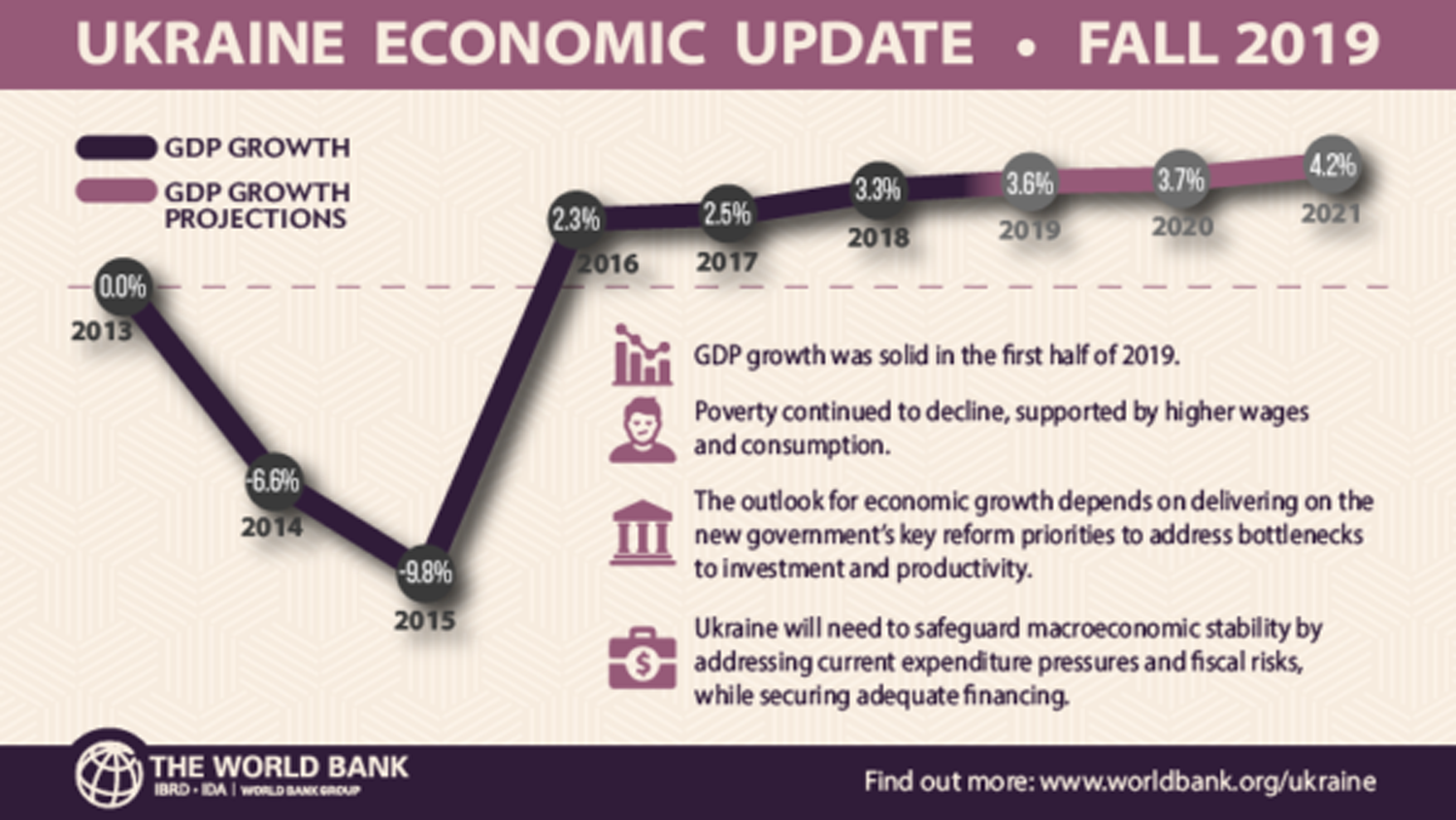Due to the slowdown in inflation and a decrease in the NBU key rate, the cost of lending will gradually decrease, while at the same time, the volume of loans will go up. This will be a powerful stimulus for the economy, allowing a faster growth than it was in 2019. As a result, the annual growth of real GDP will exceed 4%.
-
 OVERVIEWUKRAINE ECONOMY
OVERVIEWUKRAINE ECONOMY

Economic growth in Ukraine picked up to 3.6 percent in the first half of 2019 and 4.2 percent in the third quarter driven by a strong agricultural harvest and consumption growth from higher wages, remittances, and a resumption of consumer lending, according to the World Bank’s latest Ukraine Economic Update. At the same time, investment growth has not yet picked up to levels needed for stronger and sustained economic growth.
“The growth of the Ukrainian economy in 2019 may become the highest in the last eight years, while inflation – the lowest over the past six years. The country’s leading experts provided their economic forecasts for 2020 and identified key risks.”
At the end of 2019, Ukraine is seeing good economic development figures. According to estimates of the State Statistics Service, GDP growth in the third quarter exceeded 4% in annual terms. This means that economic growth over the whole year is likely to outrun the figure of 2018 at a little over 3%, being the highest over the past eight years.
The structure of the Ukrainian economy continues to transform. Industrial output in January-November dropped by 1.2%. At the same time, Ukrainian farmers in MY 2018-2019 exported the record volume of grain in the history of independent Ukraine – almost 50 million tonnes – and boasted record-high crops. Ukrainian developers are not far behind: over the eleven months they have increased the volume of their operations by more than 20%.
In the past year, non-residents discovered the Ukrainian debt market. In order to buy Ukrainian government’s domestic loan bonds, foreigners brought into Ukraine over $4.5 billion, which means, twice as much inflow of foreign direct investment in the form of equity participation in capital.
As a result of the massive influx of foreign capital into Ukrainian domestic bonds, Ukraine’s national currency has strengthened 16% since year-start, and is steadily holding up to a four-year historical maximum of UAH 23 per dollar.
Ukraine’s key lenders remain conservative in their forecasts. The International Monetary Fund predicts economic growth in 2020 at 3% with inflation of 5.6%, while the World Bank suggests GDP growth of 3.7% with inflation of 5.5%.
The forecasts of the Ukrainian authorities are almost identical. The National Bank expects economic growth at 3.5% with inflation at 5%. The 2020 state budget is based on the government forecast with a GDP growth of 3.7% with inflation of 5.5% and an average annual rate of UAH 27 to the dollar. However, the latter figure will be adjusted in the near future.
The current positive trends of 2019 will prevail, including growing business activity, consumer confidence, and lower risks of an escalation of the military conflict in eastern Ukraine. Moody’s will increase Ukraine’s rating to “B3” or higher. Rated at at “B” level by world’s three leading rating agencies, Ukraine may count on a higher inflow of foreign capital.

EXPERT
-
International Monetary Fund
-
World Bank
-
National Bank of Ukraine
-
Government of Ukraine
-
ICU Group
-
Concorde Capital
-
IG Univer
-
Ukrainian Institute for the Future
-
Ukrainian Institute for the Future
Expected Annual GDP Growth %
-
3.0
-
3.7
-
3.5
-
3.7
-
3.2
-
3.0
-
4.0
-
4.4
-
3.6
Inflation at year-end, %
-
5.6
-
5.5
-
5.0
-
5.5
-
5.3
-
4.8
-
5.0
-
7.0
-
5.4
Hryvnia rate at year-end, UAH / USD
-
----
-
----
-
----
-
----
-
25.50
-
26.00
-
21.00
-
27.00
-
25.75
If we summarize the experts’ estimates, the Ukrainian economy in the coming year is likely to show modest growth, just as this year, while the inflation rate will remain relatively low. The national currency will remain strong relative to the crisis years, but may weaken somewhat compared to the current UAH 23 per U.S. dollar.
In other words, 2020 promises to be a logical continuation of the outgoing year. So a breakthrough with an annual economic growth of 5-7%, promised by the government and necessary to significantly improve living standards, will once again be delayed.

